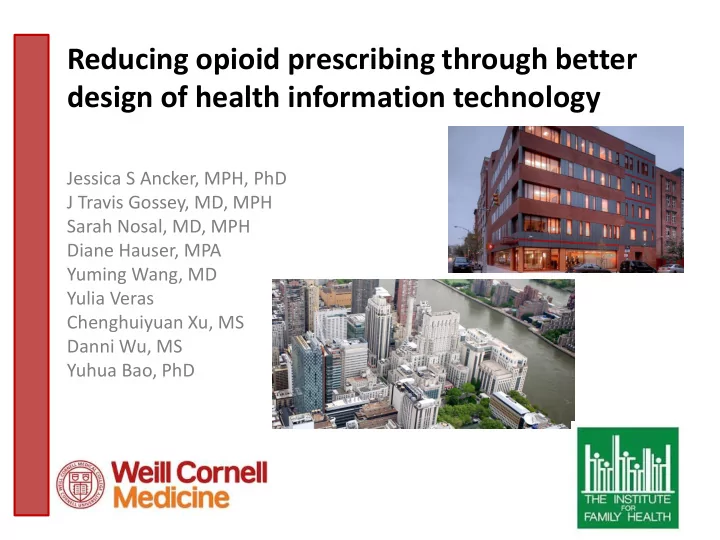

Reducing opioid prescribing through better design of health information technology Jessica S Ancker, MPH, PhD J Travis Gossey, MD, MPH Sarah Nosal, MD, MPH Diane Hauser, MPA Yuming Wang, MD Yulia Veras Chenghuiyuan Xu, MS Danni Wu, MS Yuhua Bao, PhD
Opioid overdose is now a leading cause of death in the United States One of the many contributors to the opioid epidemic has been easy access to prescription opioids 2
https://www.sciencedirect.com/science/arti cle/pii/S235291481730148X 3 https://dashboard.healthit.gov/quickstats/pag es/physician-ehr-adoption-trends.php
The health information technology community often tries to design sophisticated clinical decision support (CDS) to improve prescribing choices Prescriber CDS system makes Prescriber recommends selection in revises order evidence-based ! eRx system alternative • But prescribers now override >90% of alerts • Alert fatigue adds to usability burden of electronic health records Gardner et al. Physician stress and burnout: the impact of health information technology. JAMIA 2019. https://academic.oup.com/jamia/article/26/2/106/5230918 4
Instead, we decided to exploit the power of the default option, which has a strong but unobtrusive effect on decisions AMIA 2017 | amia.org 5
Our innovation “nudges” physician prescribing behavior in the right direction by resetting the default Typical e-prescribing order entry: 1. Physician enters drug name in new order Oxycodone 15 mg oral tablet 2. Physician then selects One tab every 6 hours quantity, frequency, etc 12 3 0 Our innovation: 1. Physician enters drug name in new order 2. If drug = short-acting opioid: • Order autopopulates with CDC-recommended minimum for opioid-naive patients 3. Physician can easily overwrite 6
Academic multi-specialty practice in New York City, ambulatory sites only Federally qualified health center, >30 sites in and around New York City 7
Among Weill Cornell physicians, we saw several years of increasing adoption of CDC-recommended prescribing practices, followed by an abrupt increase when we implemented the innovation The intervention was also associated with a lower proportion of high-quantity prescriptions (more than 7 days’ supply) However, the innovation had little effect at the Institute for Family Health, where providers were already much more likely to follow CDC-recommended prescribing practices for new patients 8
Why does the default option affect our choices? 1. Effort – Staying with the default is easier than switching 2. Endorsement – Decision-makers infer that the default option is endorsed by the authority who set up the social or technical system In this case, the inference is correct Dinner et al, J Exp Psych 2011 9
In this project: A redesign of the e-prescribing order form strongly affected prescribing choices without interrupting workflow There was a ceiling effect; the intervention had no effect in an organization where congruence with recommended prescribing practices was already high But even in this organization, the intervention reduced the number of clicks needed to write a prescription for the majority of prescribers 10
It’s virtually unheard -of for informatics innovations to reduce keystrokes Weill Cornell: 50% increase in congruent prescriptions with 40% decrease in keystrokes IFH: No difference in congruent prescriptions but a 60% decrease in keystrokes 11
Alternatives to traditional clinical decision support can encourage guideline-congruent prescribing while reducing EHR burden We ‘nudged’ providers to prescribe several hundred fewer high - quantity opioid prescriptions, and made their job easier There seems to be an upper limit on how far ‘nudges’ can change prescribing choices 12
Jessica Ancker, PhD J Travis Gossey, MD Yuming Wang, MD Sarah Nosal, MD Diane Hauser, MPA Yulia Veras Associate Professor Medical Director Informatics CMIO, Administrative HIT Analyst of Information Specialist VP for Innovation director Services & Optimization This project is generously funded by the New York State Health Foundation (17-05047) Samprit Yuhua Bao, PhD Chenghuiyun Xu, MS Thank you! Banerjee, PhD Associate Statistical analyst Associate Professor Jessica S Ancker, MPH, PhD Professor jsa7002@med.cornell.edu 13
Recommend
More recommend